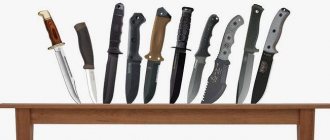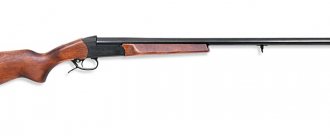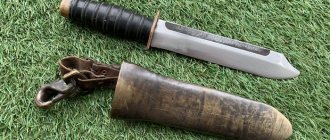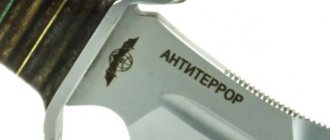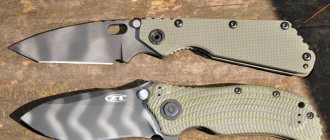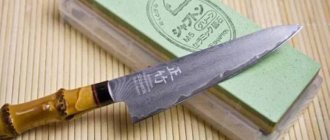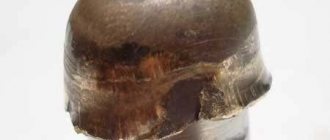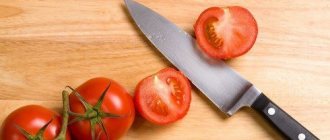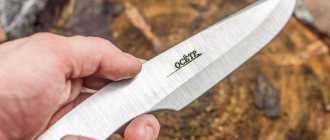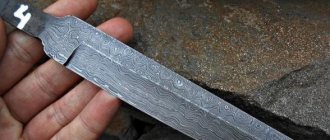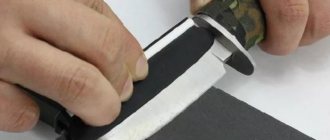There are many types of kitchen knives of different shapes, sizes and purposes - it is not surprising that it is difficult for untrained people to understand which ones are intended for what.
It's common for new cooks to purchase knife sets and certainly get some useful knives into their arsenal this way. But do you really need all these types of knives from sets? Not really.
In this article, I will help you navigate the variety of kitchen knives and tell you which knife is intended for what purpose, and most importantly, whether you really need it.
Content:
- European knives: Chef's knife
- bread knife
- Paring knife
- Fillet and bone knives
- Utility knife
- Guito
- Hatchet knife
- Direct
Blade sections
The functionality and convenience of a knife is determined primarily by the profile of the blade, which is specified during its manufacture. The main components and concepts of the blade are:
- 1 – cutting edge;
- 2 – descents;
- 3 – ribs;
- 4 – golomen;
- 5 – butt;
- A – blade width;
- B – web width;
- C – width of slopes;
- D – inlet width;
- E – butt thickness;
- F – Thickness of slopes at the inlet.
All these parameters can be seen in the picture below.
Blade cross-section diagram.
European knives
Chef's knife (chef's knife)
Chef's Knife
One of the essential knives that should be in every kitchen. The length of the blade varies from 15 to 30 cm (6-12 inches), thickness - 2-4 mm, width (height) - on average 40-47 mm. As the length increases, both the thickness and width of the knife usually increase. A wide blade can be useful - it can be used as a spatula for carrying food.
Typically, chef knives are available with blades 15, 20, 25 and 30 cm long. A blade shorter than 20 cm is not very convenient for most types of work, and for a blade longer than 30 cm you need to have a large work table and cutting board.
If you are a beginner cook, then choose a medium chef knife with a 25 cm blade. Or you can buy two knives: a large chef knife with a 30 cm blade and a 20 cm Santoku knife (read about them further). In this case, you will use the Santoku knife as your main one.
A chef's knife is sometimes called a "French Knife". It has a long triangular curved blade. The flex allows the user to rock the knife back and forth while slicing, as well as create a lot of pressure on the part of the blade that is close to the handle.
The chef's knife is quite versatile, perfect for various kitchen jobs:
- chopping small ingredients (herbs, garlic) using the heel of a knife;
- cutting onions, vegetables using the tip of a knife;
- cutting large hard vegetables (cabbage, potatoes, cucumbers, etc.) and meat using the middle part of the blade;
- crushing garlic and other ingredients using a wide blade.
The main purpose of the knife is shredding. This is what occupies most of the time of professional chefs. It is not recommended to use this type of knife for slicing soft bread.
Serrated bread knife
Bread Knife
A serrated knife will help you cut any bread. It is able to cut through a stale crust without damaging the flesh. The serrated (or serrated) blade also makes it easy to cut tough-skinned foods like watermelons, melons, and pineapples, and soft foods like cakes.
These knives are made of durable steel and have a rounded edge. When choosing a bread knife, pay attention to the length of the blade - it should be no shorter than 25 cm. The longer the blade of the bread knife, the more useful it will be.
Paring knife
Peeling Knife
A Peeling Knife is a must-have for every cook's kitchen because most of the tasks it performs cannot be done by any other knife.
This is a lightweight and convenient knife with a short blade up to 10 cm long. It will be useful for cutting thin peels, cutting out potato “eyes” or cutting thin citrus slices to decorate alcoholic cocktails and more. When choosing a knife for peeling vegetables, you should not focus on price. Usually simple and cheap models do an excellent job.
The classic vegetable knife is a smaller copy of a chef's knife. There are also “Sheep Foot” cleaning knives, similar to smaller Santoku.
Sheep Foot Knife
Sheep Foot knives have a straight blade that makes it easier to peel fruits and vegetables while holding them in your hand. When using a cutting board, a classic blade performs better.
There is also a cleaning knife with an unusual “claw” blade shape. These knives are called "Bird's Break" or "Tourne Knife". In Japan they are called "Petty".
Birds Break knife
This knife has a rounded blade and is used for peeling round vegetables and fruits (apples, pears, oranges, potatoes, etc.). The ability to use such a knife is a sign of chef skill.
fillet knife
Fillet knife
A fillet knife is a kitchen knife with a thin, flexible blade up to 30 cm long, which is designed for slicing large fish (such as salmon) into thin slices or separating fillets from the bones. You will only need this knife in your home kitchen if you regularly fillet fish, in which case it will perform really well. In other cases, there is no point in purchasing it. In addition, learning to use such a knife correctly requires a certain amount of practice.
A type of fillet knife is a boning or bone knife (Boning Knife). It has a wider and shorter blade (10-15 cm long) and is designed for removing meat from bones rather than cutting fish.
Carving knife
Utility knife
Utility Knife
A Utility Knife is a basic knife designed solely to fill space in knife sets (such as those shaped like a wooden block with slots).
You definitely don't need this knife in your kitchen. Its blade length is usually between 12 and 18 cm, so it is too big for peeling vegetables and too small for anything else. Instead of a utility knife, buy a good chef's knife, paring knife, and bread knife. You will have much more fun using them.
Collectible models
Collectible models are valued for the unique work of the craftsmen. They are distinguished by artistic design and high-quality materials. Used for hunting, in the kitchen and for interior decoration. The cost of exclusive knives starts from 5 thousand rubles, rare options can cost up to 1 million rubles.
Types of collectible knives:
- Gift - used as gifts or for interior decoration. Prices depend on the material and design of the blade. A model with additional built-in blades costs from 2 thousand rubles, a designer one from 10 thousand rubles.
- National - differ in material, method of wearing, decor. The shape of the knife blade reflects the culture of the people. The price starts from 10 thousand rubles.
- Custom - made to order in limited editions. These knives are often handcrafted by renowned craftsmen. The form can be any. Price from 100,000 rubles.
Even the highest quality knife should not be used for other purposes. This can lead to a fracture of the tip and affect cutting properties. The blade will have to be sharpened more often. But if you take into account the features of a particular model, the knife will last longer.
Gift
National
Custom
Japanese knives
Most Japanese kitchen knives (Oriental Knives) are traditionally handmade, intended for very narrow culinary tasks and designed for professionals. There are more than 200 types of kitchen knives in the land of the rising sun, and only 2 of them are specifically made for household use - Santoku and Nakiri.
There are two classes of Japanese knives: hon yaki and kasumi. They differ in the manufacturing method and the steel used.
Honyaki knives are expensive and are intended for professional chefs. They are very hard and difficult to sharpen. If these knives are handled incorrectly, chipping may occur.
Kasumi knives are suitable for both professionals and amateurs. They are more affordable and easier to sharpen.
Japanese knives differ from European ones in their sharpening. European ones are sharpened on both sides at an angle of approximately 20 degrees. Japanese ones are sharpened only on one side at an angle of 8-15 degrees (double-sided sharpening knives produced in Japan are exported).
Due to the fact that Japanese knives are made of steel with a high hardness index (from 58 HRC and above), they need to be sharpened only on a machine (a regular sharpening stone will ruin the edge). European knives are softer, their steel hardness is from 56 to 58 HRC.
Gyutou
Japanese Guito knife
The Guito knife is the Japanese equivalent of the European chef's knife. It is made with blade lengths of 18, 21, 24, 27 and 30 cm. Unlike the French knife, it has a sharpening of about 12-15 degrees (the European chef sharpens more strongly - from 20 degrees on each side).
Santoku
Japanese Santoku knife
Translated from Japanese, “santoku” means “three virtues,” which fully corresponds to the purpose of the knife - it is good for slicing, chopping and chopping. The blade length of such a knife is from 12 to 20 cm. It is thinner than a chef’s knife, so it allows for more precise cutting. Santokus are not weighted at the base of the handle and, due to the lack of bending, the blades do not lend themselves to a rocking motion like French knives, making them poorly suited for chopping greens.
If you choose the 20cm Santoku, you will use it for 90% of what you usually do in the kitchen. This knife is perfect for cutting vegetables, cooked meat or cutting poultry. When purchasing, make sure the knife fits well in your hand. If you are going to use a knife to cut vegetables, then choose models with a Granton-type blade (with notches or holes). They prevent ingredients from sticking.
Sabaki
Japanese Sabaki knife
A Japanese analogue of a bone knife with a blade length of 18 to 21 cm. Also called “honesuki-kaku”. Used for cutting meat and poultry.
Honesuki and Garasuki
Japanese knives Honesuki (bottom) and Garasuki (top)
Both of these knives are designed for cutting poultry (chicken, turkey, goose) and have a triangular blade tip. They differ only in size: Honesuki is a smaller version of Garasuki. These knives can have both double-sided sharpening (asymmetrical) and traditional single-sided sharpening. Models with European and Japanese handles are available.
Deba
Japanese Deba knife
The Japanese Deba knife is a thick and heavy kitchen knife with a blade length of 16.5-22 cm. Designed for cutting fish. It has a traditional Japanese handle and one-sided sharpening. Models with a double-sided sharpening are called Ryo Deba, and those with a European handle are called Yo-Deba.
There is a variety of Deba knife called Kanisaki Deba. This knife is designed for cutting crabs, lobsters, lobsters and other crustaceans. Sharpening is carried out on the left side for right-handers and on the right side for left-handers, which allows you to open the shells without damaging the meat. The blade length of Kanisaki Deba is from 180 to 210 mm.
Japanese knife Kanisaki Deba
Another variation of the Deba knife is Mioroshi Deba, which means “filleting” in Japanese. It is, in fact, intended for cutting and slicing bony fish into fillets. Mioroshi Deba has a blade from 18 to 27 cm long, 5-6 mm thick and up to 5 cm wide. Mioroshi Deba looks exactly the same as a standard Deba knife, but it is longer and thinner.
Nakiri
Japanese Nakiri knife
Kitchen knife for cutting vegetables. The width of the Nakiri blade is from 5 to 6 cm, length - from 12 to 18 cm. The sharpening angle is 4-6 degrees (almost the same as the angle of descent).
According to most professional chefs, if you have a Guyto and Nakiri knife in the kitchen, then there is no need for Santoku.
Manufacturing materials
The handle is an important part of all types of knives; different types of materials are used for its manufacture: wood, leather, metal, birch bark, plastic, synthetic fibers, bone. The most common are:
- Wood - fits nicely in the hand, light in weight, attractive in appearance. This is a wear-resistant material that does not allow moisture to pass through due to its density. Among the advantages are low weight and easy processing. The disadvantages include moisture absorption and the inability to withstand strong impacts.
- Plastic is durable and practical to use. Electrical insulating plastic is shock resistant. The rubberized one fits tightly to the hand and does not get cold in winter.
Metal
Tree
Plastic
Leather
Bone
Steel is usually used to make blades; ceramics are also used for kitchen knives. Unlike other models, ceramic knives do not become dull for a long time, do not change the taste of food, and are light in weight. Their main disadvantage is chipping from strong impacts and the difficulty of sharpening at home.
As for steel, it can be stainless, carbon, single-layer or multi-layer. Stainless steel models are easy to care for, but hold an edge less well. Today, many manufacturers offer stainless steel blades with a fairly high hardness rating on the Rockwell scale.
Carbon steel is harder, it holds an edge well, and has high cutting properties. Its main drawback is its poor corrosion resistance, which is why the blade requires maintenance. Carbon steel knives are most often used in professional kitchens.
Laminated steel is made by welding and re-forging multiple layers of steel to create patterns on the blade. The central layer of this steel is high-carbon, so the knife does not become dull for a long time. The outer layers have a higher chromium content to prevent the blade from rusting. The only disadvantage of such blades is their high cost.
The universal material for the handle is plastic. It is more wear-resistant, easy to maintain, and lightweight. The best option for a blade is steel with a chromium content of at least 12%, with a hardness of 58-60 on the Rockwell scale.
Steel
Ceramics
Special knives
Hatchet knife
Hatchet knife
The kitchen hatchet (Cleaver) has a thick and wide blade 15-18 cm long. It is a powerful, massive knife designed for heavy tasks such as chopping bones or frozen meat. Its enormous weight helps to apply the greater force required to chop meat. As with a fillet knife, you will only need a hatchet in very rare cases. At the same time, inept handling of it promises significant problems. Therefore (in our opinion) this type of knife is not needed at all in amateur kitchens.
Knife "Tomato"
Tomato knife
A special knife with a short (up to 13 cm) serrated blade. Designed for cutting vegetables and fruits with thick skin and soft pulp, in particular for tomatoes. It has a forked edge, which is convenient for lifting cut pieces of product.
Sausage knife
Sausage Knife
A knife with a serrated blade 14-16 cm long, designed for cutting sausage. Just like a tomato knife, this type of knife can be used to cut any product with a hard skin.
Steak knife
Steak Knife
A Steak Knife is a narrow knife with a raised tip, a straight spine and a curved wooden handle. The length of the blade of such a knife is up to 13 cm. It often has a serrated blade. Used as a serving knife for steaks.
This type of knife first appeared in America after World War II. Steak knives are not only functional, but also very beautiful. They are often sold in sets with which you can decorate your holiday table.
Cheese knife
Cheese knife The
Cheese Knife is designed for cutting soft varieties of cheese. It has a short blade up to 13 cm long, a serrated cutting edge and a forked point. This knife has large holes in the blade that prevent cheese from sticking. The knife is also suitable for cutting cakes and pies.
In addition to the classic cheese knife, there are various devices for slicing cheese, for example a cheese slicer or Girolle.
Cheese slicer
Cheese slicer
Used for cutting semi-hard and hard cheeses. With this device you can cut very thin slices, which are great for making sandwiches. It can also be used to cut cold butter, zucchini, cucumbers or cabbage.
The modern cheese slicer was invented by Thor Bjorklund in 1925 in Norway, and its mass production began in 1927 in the city of Lillehammer. This type of slicer is very common in the Netherlands, Belgium and Germany.
Girol
Girolle
Girolle is a special device for circular cutting of cheese in the form of “chanterelles” (“girolle” is translated from French as “chanterelle”, hence the name). Traditionally used for cutting Tête de Moine cheese. This knife was invented in 1982 by Nicolas Crevoisier in Switzerland.
Butter knife
There are two types of butter knives: master knife and custom (personal). Both of these knives have a wide blade and a relatively dull blade. The difference is that the master knife has a curved, pointed tip and is shaped like a saber. It is intended only for cutting and serving butter, because... It is believed that if you spread butter on bread, crumbs may get into the butter dish.
Master butter knife
A personal butter knife has a rounded tip and is used specifically for spreading butter on bread during meals. These knives have small serrations at the end of the blade designed to cut soft buns.
Personal butter knife
Caviar knife
Caviar knife
A caviar knife is usually used to set festive tables and spread the product on bread or pancakes. Under normal conditions there is no need to use such a knife. It has a wide round tip that is useful for catching caviar, and is traditionally made of mother-of-pearl, gold, animal horns or wood. It is believed that the metal changes the taste of caviar, but there is no scientific evidence for this.
Pizza knife
Pizza roller
There are several types of pizza cutters: roller, traditional, mezzaluna (translated from Italian as “crescent”). The first option is the most popular. It is a round blade with a handle that needs to be rolled over the pizza.
Traditional pizza cutter
A traditional Italian pizza cutter has a long curved blade and an additional stop on the blade. It can also be used for slicing cheese.
Mezzaluna
The mezzaluna needs to be rocked back and forth to cut the pizza. This knife is also often used for chopping greens.
Garlic peeler
Garlic knife
An unusual type of kitchen knife. It has a wooden handle and a very short blade, which is convenient for peeling or cutting fresh garlic.
Oyster knife
Oyster Opening Knife
Designed specifically for oyster lovers. With such a tool in your kitchen, opening shellfish will be a real pleasure!
Opening oysters with a regular kitchen knife is not only inconvenient, but also unsafe: you can damage the oyster meat or the shell, particles of which will get into the meat, and in the worst case, you can get injured.
The oyster knife is designed in such a way that it prevents the shell from splitting and damaging the oyster meat. It has a short, thick blade with a pointed end and makes it easy to open shells. Some models are equipped with protection for your fingers. For additional protection, professional chefs use special gloves when opening oysters.
Watermelon knife
Knife for watermelon or melon
A watermelon knife is specially designed for cutting large fruits and berries, such as melons and watermelons. Its long, serrated blade allows you to cut through tough skins with ease.
Frozen food knife
Knife for frozen foods
Cutting tightly frozen foods (such as meat) with a regular kitchen knife is quite difficult. For this purpose, it is better to use a special knife with a sawtooth sharpening. It allows you to cut frozen foods without much effort and without fear of damaging the knife blade.
Often such a knife is sharpened on both sides: one side is intended for cutting frozen foods, the other for bread.
Traditional Asian knife for cutting fish
Professional fish fillet knife
This knife with a round blade is used by Asian chefs for cutting large fish, in particular tuna. It is convenient for both filleting and cutting bones.
It can be of any size, on average the blade length is 130-160 mm.
Side profiles of blades
There are many types of side profiles. The following are considered the main ones:
- The blade intended for cutting and stabbing has a straight spine.
- Blade with a lowered spine line (drop-point). This product cuts and stabs well, the tip is located on the axis of force application. It is slightly lighter in weight than a blade of the same length with a straight spine. A false blade is often made on this part.
- Blade with an increased trailing point. This shape provides a long cutting edge, which is quite convenient when cutting durable materials.
- Bowie wedge (clip-point). The shape is very similar to a wedge with a lowered butt line, but the tip is thinner. A special bevel of the blade brings the tip closer to the line of application of force during a piercing blow. This bevel is sometimes sharpened; this type is popular in America.
- Goat leg type blade. The product is designed for thin and precise cuts, which is facilitated by a straight blade. The knife is quite safe and cannot be used to stab.
- Tanto type blade. Many historians claim that this shape originated from Japanese knives. But in reality it was invented in America. And classic tanto knives had a straight line of the spine. The product is convenient for cutting actions, and with a forceful injection, the tip is less likely to chip.
- Spear-shaped wedge. Most often these are double-edged products with the tip located on the midline. These knives are more suitable for stabbing. Most often, daggers are made this way.
Blade profiles.
Types of cutting edges
Direct
Straight Blade Edge
The standard blade edge on most knives.
Toothed, serrated (Serated)
Serrated blade edge
Serrated blade knives are difficult to keep sharp. Even the most expensive models, made of the best steel, become dull over time, and sharpening such a knife is a difficult task. A serrated knife should be cheap because it only performs its task well for a short time (1-2 years). After that, it’s easier to throw it away and buy a new one than to sharpen it.
The serrated blade is suitable for a very narrow range of tasks, namely slicing fresh bread, baked goods or frozen foods. In a pinch, this blade can be used to cut steak.
Scalloped
Wave-shaped blade edge
Knives with a wave-shaped blade are similar to serrated blades, but they cope much better with delicate work, such as cutting meat into slices, and are much easier to sharpen.
These knives were originally created for slicing pastries, but they are also great for cutting bread. A knife with a wavy blade leaves a cleaner cut than a serrated one.
Notched (Granton)
Granton blade
Granton blades (with pockets) are designed to ensure that food sticks to the knife less and that when chopping, already cut pieces do not fly away in all directions. This type of blade is called "Granton Edge". It received its name in honor of the woman who first invented and patented air pockets.
Handle types
An important element of any knife is the handle. For a good cut, you need to hold the blade comfortably in your hand. The shank, which is located inside the handle, is made by knife makers in accordance with future installation. Let's look at what types of handles there are:
Horseback
A very common type of installation, especially from well-known manufacturers. Considered very reliable. The blade shank is inserted into the handle to the middle of its length.
Through
The most reliable installation option, but quite labor-intensive. The blade's tang runs through the entire handle.
Overhead
The shank itself serves as a handle; other materials are applied to the side surfaces and secured with rivets.
Welded
This method is used when installing metal handles, which become a monolithic structure with a shank.
